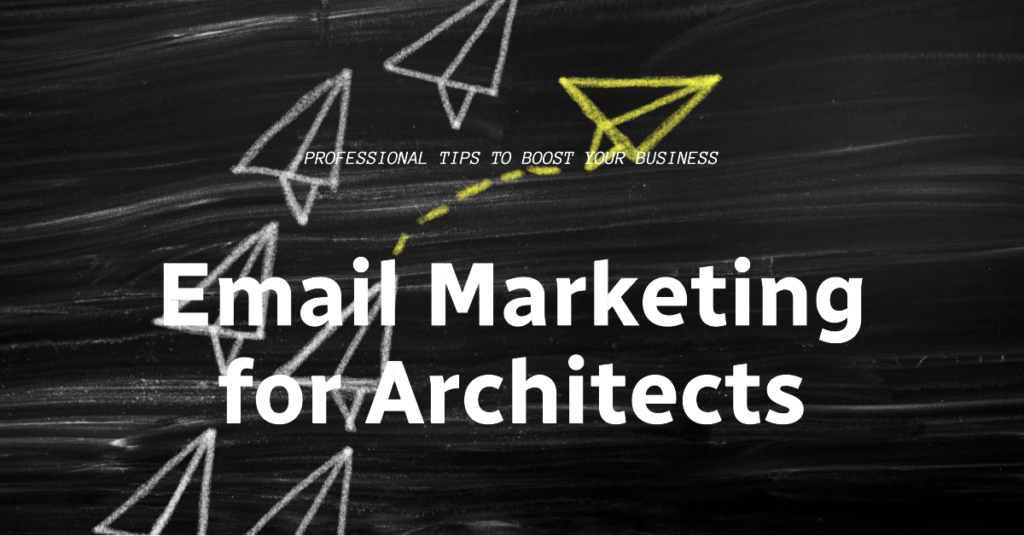
Table of Contents
1. Introduction: Harnessing the Power of Email Marketing for Architects
In today’s digital age, architects and design firms are leveraging various marketing strategies to showcase their expertise, attract clients, and stay competitive. Email marketing stands out as a potent tool for engaging potential clients, nurturing leads, and fostering long-term relationships. This section introduces the significance of email marketing in the architectural domain and sets the stage for exploring key strategies.
2. Building Your Email List: Quality Leads for Targeted Campaigns
Building a robust email list is foundational to successful email marketing. Architects can employ various strategies to capture quality leads, including optimizing their website for email subscriptions, leveraging social media platforms, participating in industry events, and networking proactively. Offering valuable content such as downloadable resources, design insights, and project case studies can entice visitors to subscribe, ensuring a pool of engaged recipients for targeted campaigns.
3. Crafting Compelling Content: Showcasing Expertise and Projects
Email content plays a pivotal role in engaging recipients and driving desired actions. Architects should focus on crafting compelling content that showcases their expertise, recent projects, design philosophies, and industry insights. Incorporating visually appealing elements such as project renderings, videos, and client testimonials can captivate recipients’ attention and highlight the firm’s unique value propositions. Providing educational content about architectural trends, sustainable practices, or innovative design approaches can also position the firm as a thought leader in the industry.
4. Personalized Campaigns: Tailoring Messages for Different Audiences
Personalization is key to creating meaningful connections through email marketing. Architects can segment their email list based on criteria such as project interests, industry sectors, geographic locations, or client personas. By tailoring messages and offers to specific audience segments, architects can deliver relevant content that resonates with recipients’ needs and preferences. Personalized emails addressing recipients by name, offering targeted content recommendations, and acknowledging their past interactions with the firm can significantly enhance engagement and conversion rates.
5. Automation Tools: Streamlining Campaigns for Efficiency
Utilizing email marketing automation tools can streamline workflows, save time, and enhance campaign effectiveness for architects. Automated workflows can be set up for welcome emails, follow-ups on inquiries, project milestones, and newsletters based on recipient actions or predefined triggers. By sending timely and relevant messages automatically, architects can nurture leads, maintain client relationships, and stay top-of-mind with minimal manual effort. Additionally, automated drip campaigns can guide leads through the sales funnel, providing them with relevant information at each stage of their buyer’s journey.
6. Visual Appeal: Engaging Recipients with Stunning Design Elements
Incorporating visually appealing design elements in email campaigns is crucial to capturing recipients’ attention and conveying brand identity effectively. Architects can showcase project images, architectural drawings, 3D renderings, and videos to highlight their design prowess and aesthetic sensibilities. Consistent branding, clear call-to-action buttons, and mobile-responsive designs ensure an immersive and seamless user experience across devices. Including interactive elements such as polls, quizzes, or clickable hotspots in emails can also boost engagement and encourage recipients to interact with the content.
7. Analytics and Insights: Data-Driven Decision Making
Analyzing email marketing metrics provides valuable insights into campaign performance, recipient behavior, and engagement levels. Architects can track metrics such as open rates, click-through rates, conversion rates, and subscriber growth to evaluate campaign effectiveness and optimize future strategies. A/B testing subject lines, content formats, visual elements, and call-to-action placements can also help refine campaigns for better results. By leveraging data-driven insights, architects can make informed decisions, identify opportunities for improvement, and continuously optimize their email marketing efforts.
8. Compliance and Privacy: Adhering to Regulations for Trust and Transparency
Maintaining compliance with data protection regulations such as GDPR and CAN-SPAM Act is essential for building trust with email subscribers and safeguarding sensitive information. Architects must obtain consent for email communication, provide clear opt-out options, and secure data storage to ensure privacy and transparency in their email marketing practices. Respecting recipients’ preferences, honoring unsubscribe requests promptly, and avoiding misleading or deceptive email practices are fundamental principles that architects should uphold to foster trust and credibility with their audience.
9. Nurturing Client Relationships: Beyond Transactions to Long-Term Partnerships
Email marketing for architects extends beyond promotional campaigns to nurturing client relationships and fostering long-term partnerships. Sending personalized messages on project anniversaries, industry updates, or relevant design trends showcases a firm’s commitment to client satisfaction and adds value beyond project deliverables. Building rapport and trust through consistent communication, soliciting feedback, and addressing client inquiries promptly can strengthen brand loyalty and encourage repeat business and referrals. Architects can also leverage email marketing to invite clients to exclusive events, webinars, or workshops, further enhancing engagement and fostering a sense of community among clients and stakeholders.
10. Conclusion: Elevating Architectural Marketing with Email Strategies


In conclusion, email marketing serves as a dynamic and cost-effective tool for architects to showcase their expertise, engage with prospects and clients, and drive business growth. By implementing targeted campaigns, leveraging automation tools, delivering compelling content, and analyzing performance metrics, architects can unlock the full potential of email marketing in amplifying their brand presence, securing valuable projects, and nurturing long-lasting client relationships in a competitive landscape. Embracing creativity, personalization, data-driven strategies, and ethical practices are key pillars that architects should embrace to excel in their email marketing endeavors and achieve sustainable business success in the architectural industry.


